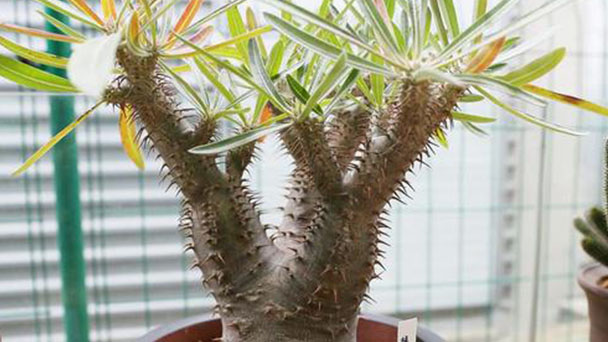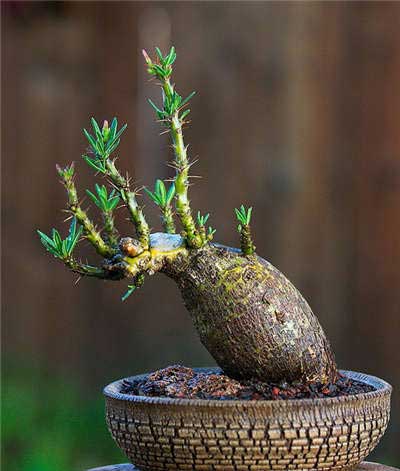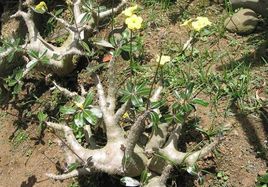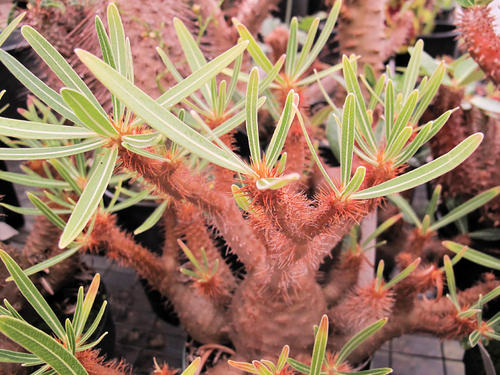Elephant's Trunk Plant (Pachypodium Namaquanum) Profile
Written by Maggie
Dec 07 2021

Elephant's trunk plant, scientific name Pachypodium namaquanum, is the genus Oleander, originally from Namibia, also known as the Light Hall. Elephant's trunk plant stem is 1.5 -- 1.8 m tall, unbranched, and the stem is densely spines 5 cm long. The thorns are very characteristic, although it does not have a thorn base, but it is still 3 thorns born together, two long pieces of a figure of eight separated, there is a short thorn in the middle, the thorns are brown. Growth period stem apical cluster growth ovate leaves, green, 8-12 cm long, 2-6 cm wide, midvein is obvious, light color, leaf margin wavy. Leaves fall off in the dry season.
Elephant's Trunk Plant Picture

Characteristics of Elephant's Trunk Plant
Elephant's trunk plant (Pachypodium namaquanum) is a succulent plant of the oleander family, native to Namibia. Elephant's trunk is a typical xerophyte. The fleshy stem is 1.5-2 m tall, unbranching, and only sprouts a few new shoots below the wound after the growing point has been destroyed. Stems of Elephant's trunk are densely 2-5 cm long spines; The thorn is very characteristic, although it does not have a thorn seat, but it is still three thorns born together, two long thorns were separated in a figure of eight, sandwiched a short thorn, thorn is grayish brown, the leaf is born under the three thorns. Leaf blade is ovate to lanceolate, green, 8 -- 12 x 2 -- 6 cm, midvein conspicuous, lighter in color, prominent on abaxial surface, margin flat or wavy; Leaves of Elephant's trunk fall off in the dry season. Flowers born in the axils of leaves, yellow, reddish-brown hair, aromatic.High ornamental value.
Elephant's trunk plant is a fleshy shrub with swollen stems that can grow to 2.7 m in height. The stems of large trees are covered with short, straight, prickly branches. The flowers of Elephant's trunk are yellow, sometimes dark yellow or orange in spring. Stems with elliptical, dark green leaves. Elephant's trunk is found in the granite formations of Madagascar at an altitude of 1500 meters. When flowering, the corolla is almost horizontal.
Elephant's trunk plant is blooming in spring.
Ecological Habits of Elephant's Trunk Plant
Pachypodium namaquanum likes warm and sunny, suitable temperature for growth is 20°C-25°C. Elephant's trunk is not cold resistant, winter can not be lower than 15°C, otherwise the leaves yellow fall off, into the dormant state. Freezing damage can occur if the temperature is below 5°C. Extreme temperatures can also cause the leaves to sleep. In winter, if the temperature is kept at about 20°C, the elephant's trunk can continue to grow.If unable to maintain a high temperature, should reduce or even stop watering, make its natural dormancy, is conducive to its enhanced cold resistance, and safety over the winter.
The soil should be loose, not too viscous, and should be fertile and loose sandy loam with good drainage. It is best to use leaf rot soil, perlite and coarse sand to make up the cultivation substrate.
Elephant's trunk is a deciduous fleshy shrub. Plant height is 2.5 ~ 4 meters. Stem distally densely long acute, grayish brown. Leaves are clustered stem apex, long elliptic, apex acuminate, margin undulate.
How to Grow Elephant's Trunk Plant
Plant Elephant's Trunk Plant
When the seedlings grow more new roots after the use of a medium pot as a container for transplanting. In the operation of the first to fill a small amount of soil, and then at the bottom of the pot pad 2-3 grams of horseshoe as a base fertilizer, and then continue to fill the soil, and the seedlings will be straight, with the hand will be basin soil slightly according to the solid. Be careful not to plant Elephant's trunk plant fat stem too deep, to be stable seedlings after the appropriate amount of water once, remember not topdressing, usually without shade, can let the plant immediately accept sunlight.
Elephant's Trunk Plant Care Tips
Pachypodium namaquanum likes dry soil environment, so it is necessary to master the principle of less watering in the vigorous growth stage and no watering in the dormant stage. Pachypodium namaquanum does not like big fertilizer, in addition to the application of appropriate amount of horseshoe piece as a base fertilizer, autumn growth vigorous stage can also be every 2-3 weeks top dressing a thin liquid fertilizer. Adequate sunlight is essential for optimal cultivation, and shaded plants are slow to grow and difficult to exhibit their own characteristics.
Elephant's trunk plant likes warm and is afraid of the cold. Elephant's trunk grows well in the temperature range of 16-28℃, and the overwintering temperature should not be lower than 10℃, otherwise the plant is easy to fall leaves. Elephant's trunk can withstand short-term temperatures of 0℃. If overwatering during dormancy, elephant's trunk is susceptible to root rot, which is often attacked by red spider in drought and high temperature.In order to ensure the plants have a better growth and better appearance, we can turn the pot for the formed elephant's trunk in spring with the combination of spinning roots.
Elephant's Trunk Plant Growth
Elephant's trunk plant is perennial, which forms quickly and is not easy to age. The optimal viewing period of the elephant's trunk can be up to 10 years or even longer after the seedlings have been planted. If Elephant's trunk is too tall, you can consider seedling renewal. Under the condition of not turning over the pot, the formed plants should not be planted continuously for more than 3 years.

How to Propagate Elephant's Trunk Plant
Elephant's Trunk Plant Propagation from Seed
Seed life of Elephant's trunk plant is short, after harvest can sow namely, cover soil 0.3 cm, pour permeable with watering can. The suitable temperature for germination was 22°C -- 24°C, and germinated 15-20 days after sowing. Seedlings of Elephant's trunk are relatively delicate, pay attention to protection.
Elephant's Trunk Plant Propagation from Cuttings
The small-scale reproduction of Pachypodium namaquanum is mainly carried out by cuttings, which usually takes place from spring to autumn every year. Large-scale propagation can be carried out by sowing seedlings, seedlings after more than 6 years of planting before flowering.
Select strong branches, cut from the old plant, pay attention to the wound to be smooth. Remove the leaves of Elephant's trunk plant, in a cool and ventilated place air about 1 weeks, such as the wound natural dry shrinkage healing, inserted into the matrix, matrix better not be too wet.About 30-40 days can root, root after normal maintenance.
Species of Elephant's Trunk Plant
Whybee's Smile, White Horse, Double Stung Bottle, African King Tree, and Elephant's Trunk plants are some of the most famous succulents.
Distribution of Elephant's Trunk Plant
Elephant's trunk plant is native to Madagascar, Namibia, and South Africa.
Elephant's Trunk Plant Uses
Potted Plant
Pachypodium namaquanum has a strong ability to release dust. Even if the leaves are covered with ash, it will not matter much. Moreover, the elephant's trunk can absorb radiation and is suitable for being placed next to a computer. The family can be put in bright in the sitting room, have tropical amorous feelings extremely, ornamental value is very high.
Indoor ornamental
Elephant's trunk plant is mostly potted for indoor viewing, and it has a good effect for decorating the sunny places in the room.
Beautification effect
Elephant's trunk is drought-resistant and easy to manage; Strut form is peculiar, makes a person eye-catching, its deck is inside the bedroom that has modern breath, and can form bright contrast with the environment.
Garden Use
Elephant's trunk has a peculiar appearance and is a rare species among plants for potted ornamental. It can be used to decorate the special garden in the botanical garden, succulent lovers can collect.
Flower Language of Elephant's Trunk Plant
Elephant's trunk fly flower language is: naive.

Latest Updated
- Benefits of Bugleweed - 7 Science-backed Health Benefits
- Bugleweed Dangers & Side Effects - Is It Poisonous?
- How to Plant Evergreen Trees - What You Should Know
- When to Plant Evergreens - Grow Guide for Evergreen Trees
- 12 Wonderful Evergreen Shrubs for Your Garden
- 12 Popular Evergreen Plants with Pictures for Beginners
- When And How To Prune A Lilac Bush Like a Pro
- How to Grow & Care for Lilac Vine (Hardenbergia Violacea)
- Japanese Lilac Tree (Syringa Reticulata) Care & Propagation Guide
- Shumard Oak Pros and Cons - What to Know
Popular Articles
- Winter maintenance of Antirrhinum Majus
- How to Grow Terminalia Mantaly Tree
- How to Grow and Care for Crossostephium Chinense
- How to grow Antirrhinum Majus in spring
- Peristeria Elata (Dove Orchid) Profile: Info & Care Guide
- Underwatered Snake Plant (Sansevieria Trifasciata) - Signs And How To Fix
- How to Care for Brazilian Jasmine Plant (Mandevilla Sanderi)
- How to Grow & Care for Graptopetalum Purple Delight in Summer
- Rosa Chinensis (China Rose): Plant Growing & Care Tips
- How to Care for Baby Sun Rose (Aptenia Cordifolia)